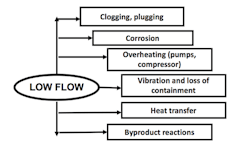Many plants now run at reduced rates because of COVID-19. This can result in low flows that present unique safety and operational problems. So, here, we’ll look at risk assessment for low flows and possible mitigative approaches.
Plant design and equipment sizing usually consider equipment turndown. However, the tacit assumption is that low rate operations will be short term. Thus, prolonged operation at low rates gets scant attention.
In view of today’s situation, you should perform a low-flow risk assessment. While you can do this in many ways, adopting the following steps generally fosters an efficient evaluation:
• Assemble a small group of experienced individuals from Operations, Maintenance, Safety and Engineering.
• Establish protocols for conducting the low-flow risk assessment.
• Divide the plant or sections of it into manageable segments or nodes that contain equipment — for example, pumps, compressors, heat exchangers, valves, pipes and control systems.
• Consider the impact of prolonged low-flow operation on each component of the nodes.
• Prioritize corrective measures.
As Figure 1 indicates, the adverse consequences of low flow can include clogging/plugging, under-deposit corrosion, pump or compressor overheating, excessive vibration and loss of containment, poor heat transfer and byproduct reactions. Of course, clogging and plugging depend on the size distribution of solids or particulates, which, in turn, depends on the process and nature of the fluid. As a rule of thumb, experts consider that velocities below 2–3 ft/s increase the chance of plugging.
It’s worth noting that low flow has some positive aspects as well. Low flow to a pump will require less net positive suction head and, hence, would help avoid or minimize the chance of cavitation when limited suction head is available for the pump. Low velocity will reduce the erosive impact in services such as those involving sand and slurry.
However, in risk assessment, we must focus on adverse consequences and the means to minimize safety/operational risk.
Figure 1. Low flow can lead to a variety of adverse impacts.
Nodal Components
Now, let’s look at some important components. Of course, this list isn’t comprehensive but it does provide examples of the types of key issues to consider and potential mitigation measures.
Pumps:
Plugging on the suction side and pump internals might occur. Plugging can further reduce flow to the pump, which, in turn, might cause cavitation depending on the liquid and its temperature and pressure drop. If a plug on the suction side creates vacuum, air could ingress, resulting in a potential fire in systems handling flammable fluids. Problems of cavitation, internal wear and air ingress are less common with positive displacement pumps but can’t be ruled out altogether.
Low velocity could cause solids to deposit on pipe as well on pump internals, with a potential for under-deposit corrosion. (See: “Keep Under-Deposit Corrosion Under Control.”)
Typically, pump rates below ≈15% of the design best efficiency point could lead to vibration or overheating. The minimum flow point depends on the pump design and type of fluid. Refer to pump curves and the vendor’s input for safe minimum flow operation. Excessive vibration could cause damage to pump components including shaft, seals, wear rings and bearings and, eventually, could result in loss of containment.
Consider:
• Operating a single pump if a service uses multiple pumps. Pumps with variable speed drives likely could accommodate low flow operation by appropriate speed reduction. If system pressure drop allows, think about trimming impeller size but realize this reduces pumping efficiency.
• Monitoring suction pipe, pump casing and insulation if solids have high corrosion potential.
• Adopting minimum flow recycle, also called spill back flow.
• Monitoring vibration and using fire and gas detectors and alarms to detect and warn of leakage from seals/flanges.
Compressors:
In a centrifugal compressor, flow rates below the surge line rapidly result in vibration, unstable operation and severe damage to rotor, shaft, seals and bearings. For flammable gas service, sub-surge flow rates quickly could lead to loss of containment and potential fire. Obviously, unstable operation also will adversely impact upstream and downstream units.
Interestingly, low-flow operation in certain ranges of flow tends to minimize potential liquid entrainment from the demisters, suction drum or suction scrubber.
Consider:
• Using anti-surge system controls and algorithms. You must provide sufficient margin above the surge line so the operation stays away from surge in the event of upsets, including rapid change in flow rates to the compressor.
• Running one compressor, rather than two, at low loads.
• Relying on unloaders or flow recycle for low-flow control of positive displacement compressors. Fixed-speed motors typically drive large compressors, so varying speed usually isn’t an option.
Heat exchangers:
Low flow operation will enhance fouling, scaling and sedimentation. Depending on metallurgy, this could lead to under-deposit corrosion. In addition, heat transfer will decrease. In some systems, this would entail more frequent cleaning/maintenance. Heat-sensitive materials could suffer higher rates of decomposition.
Consider:
• Monitoring trend in pressure drop and heat transfer coefficient.
• Using corrosion inhibitors.
Instrument systems:
Low flow operation will impair the performance of several types of sensors and transmitters.
Thermocouples and resistance temperature detectors in thermowells will show slower response, which will affect temperature control loops adversely.
Many flow meters, such as Coriolis, turbine and thermal ones, have large turndown ratios that could accommodate low flow operation without significant loss of accuracy. However, others, such as orifice plate meters with limited turndown (3 to 4), may need resizing. At low flows, gear meters could experience increased fouling.
Any pH probes in fouling/scaling service would demand more aggressive or frequent cleaning.
Although not a common occurrence, some extractive sampling systems for gas chromatographs could require repositioning of the sample tap in the pipe.
Consider:
•Re-ranging and re-calibrating sensors/transmitters that low flow operation could affect.
• Monitoring the performance of critical instruments, including those in safety instrumented systems.
• Cleaning pH probes more frequently.
• Ensuring thermowells are installed in high turbulence areas. For critical services, you may need to adopt a voting arrangement (e.g., 2oo3).
• Checking control valve openings. Typically, openings below 20% could pose controllability problems. In such cases, think about downstream throttling or replacing with a smaller valve.
Piping:
Liquid systems containing suspended solids will show a higher likelihood of deposit formation and potential under-deposit corrosion (depending on metallurgy) in low flow operations. Low vapor flow also could accelerate de-entrainment of liquid streams in piping systems. Stagnant liquid would facilitate solids deposition on pipes and could lead to under-deposit corrosion.
Consider:
• Providing appropriate treatment levels of corrosion inhibitors/dispersants (if applicable).
• Recycling flows (similar to spillback flows on pumps) for pipe segments exposed to low flow regime.
• Implementing appropriate monitoring of all potential locations where solid deposits can form.
• Periodically checking pipe thickness and insulation and updating service life based on observed corrosion rates.
Distillation columns:
Tower operating range is set by weeping/dumping at the low end and flooding at the upper end. Because distillation involves a number of subsystems, including pre-heater, column, overhead condenser, reboiler, system controls and other columns (if part of a distillation train), operating/safety problems due to low flow could manifest in multiple systems.
Possible issues that could arise include:
• Fouling or scaling systems could impair heat transfer in the pre-heater; this could cause unstable flow to the column.
• Low liquid/vapor traffic in the column could lead to unstable column operation — for instance, weeping, column dumping, and potential vapor flow through the downcomers.
• Low liquid traffic through the reboiler could foster fouling and diminish boil-up, which, in turn, will reduce vapor traffic through the column and contribute to enhanced weeping/dumping of the column.
• Control systems could become unstable because the control valve could fall outside the “good-operation-low limit,” i.e., below 20% open.
Partly because of multiple interactions, distillation operations will necessitate systematic troubleshooting efforts: monitoring operations, heat transfer rates, pressure drops and product quality.
Consider:
• Avoiding structural changes to the system, e.g., blanking off part of the trays, changing the type of packing, altering weir height, replacing the preheater or the reboiler with a smaller unit, etc., unless you expect low flow operation to endure for a prolonged period (several years).
• Making changes that will allow reasonable operation for the duration of low flows — for example, reducing the pressure of the column, increasing reflux/boil-up to boost vapor/liquid traffic, using inhibitors that could retard fouling, or maintaining stripping steam or wash oil (refining operations) to minimize poor stripping and coke formation, respectively.
• Filtering out as many suspended solids as practical before sending feed to the distillation system, including the pre-heater.
Proceed Properly
Low-flow risk assessment should be thorough and efficient. It should focus on identifying safety/operational issues of the equipment as well as upstream and downstream systems. Proper documentation and follow-up, of course, are an integral part of effective risk assessment.
GC Shah, PE, CFSE, CSP, CFPS, is a Houston-based consultant specializing in process safety, including hazard analysis and fire protection services. Email him at [email protected].



